Knots
What follows is an extensive collection of knots. Some are for the fly angler and some are just general fishing knots.
Clinch Knot* Jansik Special* Palomar Knot* Hangmans Knot* Scaffold Knot* Snelling* Blood Knot* Uni Knot* Surgeons Knot* Surgeons End Loop* Blood Bight Knot* Dropper Loop* Tucked Sheet Bend* Float Stop* Turle Knot* Double Turle Knot* Pitzen-Knot*Clinch Knot
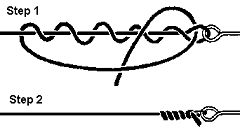
- Pass the line through the eye of the hook, or swivel.
- Double back. make five turns around the line.
- Pass the end of the line through the first loop, above the eye, and then through the large loop. Draw the knot into shape.
- Slide the coils down tight against the eye.
Jansik Special
Another beautifully simple knot that can be tied in the dark, The Jansik Special is a high strength knot tied as follows:
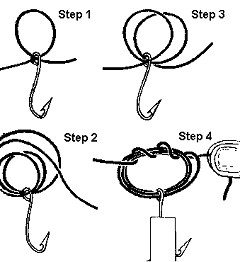
- Put 15cm of line through the eye of the hook.
- Bring it around in a circle and put the end through again.
- Making a second circle, pass then end through a third time.
- Holding the three circles of line against each other, wrap the end three times around the circles.
- Either hold the hook steady with pliers, or make it fast to boat's rigging or safety lines.
- Holding strain on the hook, pull on both ends of the line to tighten.
Palomar Knot
The Palomar Knot is another very simple knot for terminal tackle. It is regarded by the International Game Fish Association consistently as the strongest knot known. It's great virtue is that it can safely be tied at night with a minimum of practice.
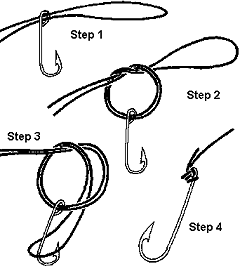
- Double about 12.5cm of line, and pass through the eye.
- Tie a simple Overhand Knot in the doubled line, letting the hook hang loose. Avoide twisting the lines.
- Pull the end of loop down, passing it completely over the hook.
- Pull both ends of the line to draw up the knot.
Hangman's Knot
There are at least 6 variations of the Hangman's Knot, - all of them excellent for terminal tackle, swivels and hooks. The "standard" Hangman's Knot holds only five turns when tied in monofilament nylon. If tied in rope, and used for its stated purpose, it takes eight turns.
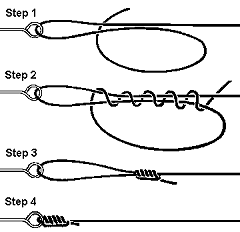
- Pass a 15cm loop of line through the eye.
- Bring the end back on itself, passing it under the doubled part.
- Make five loops over the doubled part.
- The formed knot is worked into shape.
- The knot is sent down the line, against the eye of the hook or swivel.
Scaffold Knot
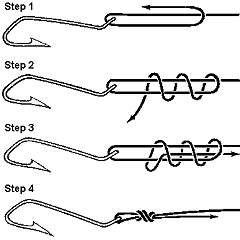
- Pass a 15cm loop of line through the eye.
- Lock the upper part between thumb and forefinger, making a loop.
- Make two more loops over the double part, holding them too, between thumb and forefinger.
- Pass the end through the two loops just made, plus the first loop made in step2.
- The formed knot can now be drawn into shape, and worked down against the eye of the hook or swivel.
Snelling A Hook

- Pass the end of the line, trace or tippet through the eye twice, leaving a loop hanging below the hook.
- Hold both lines along the shank of the hook.
- Use the loop to wind tight coils around the shank and both lines, from the eye upwards. Use from 5 to 10 turns.
- Use the fingers to hold these tight coils in place. Pull the line (extending from the eye) until the whole loop has passed under these tight coils.
- With coils drawn up, use pliers to pull up the end of the line.
Joing Line To Line
There are two top grade knots used to join one line to another, where these are approximately of the same thickness. These are the Blood Knot and the Uni Knot.
Where there diameters are very dissimilar, either the Surgeon's Knot should be used, or the thinner line should be doubled where the knot is formed.
Blood Knot
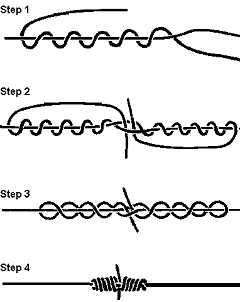
- Lie the ends of the two lines against each other, overlapping about 15cm.
- Take 5 turns around one line with the end of the other, and bring the end back where it's held between the two lines.
- Repeat by taking 5 turns around the other line, bringing the end back between the two lines. These two ends should then project in opposite directions.
- Work the knot up into loops, taking care that the two ends do not slip out of position.
- Draw the knot up tightly.
Uni-Knot
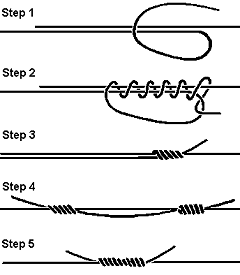 This is a knot used for attaching the line to the spool of the reel.
This is a knot used for attaching the line to the spool of the reel.
- Overlap the two lines for about 15cm.
- Using one end, form a circle that overlies both lines.
- Pass the end six times around the two lines.
- Pull the end tight to draw the knot up into shape.
- Repeat the process using the end of the other line.
- Pull both lines to slide the two knots together.
Surgeon's Knot
Earlier mention was made that if the two lines to be joined vary greatly in their diameters, the lesser line may be doubled at the knot, or the Surgeon's Knot may be used.
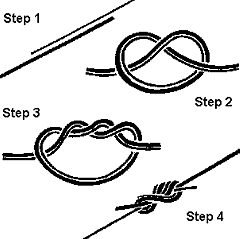
- Lay the two lines against each other, overlapping about 22.5 cm.
- Working the two lines as one, tie an Overhand Knot. It will be necessary to pull one line (say the leader) completely through this loop.
- Pull the leader through this loop again.
- Pass the other end through the loop.
- The formed knot can now be worked into shape.
Surgeons End Loop
Loops are made for the purpose of attaching leaders, traces or other terminal tackle. They have the advantage that they can be tied quickly and in the dark. The Surgeon's End Loop is an easy way to go.
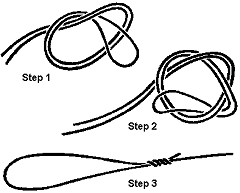
- Take the end of the line and double it to form a loop of the required size.
- Tie an Overhand Knot at the desired point, leaving the loop open.
- Bring the doubled line through the loop again.
- Hold the line and the end part together, and pull the loop to form a knot.
Blood Bight Knot
Another end loop can be tied quickly and easily using the Blood Bight Knot.
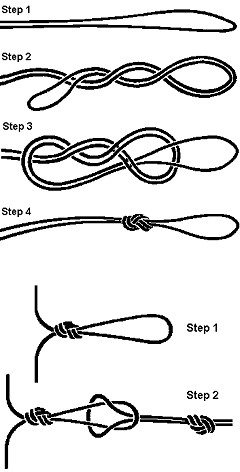
- Double the line back to make a loop of the size desired.
- Bring the end of the loop twice over the doubled part.
- Now pass the end of the loop through the first loop formed in the doubled part.
- Draw the knot up into shape, keeping pressure on both lines.
The Blood Bight Knot is often used for attaching a dropper when fishing deep water with several hooks.
Some anglers attached the hook directly to the end of the loop, which should be at least 30cm from the end of the line. This is not a good practice, especially when the fish are shy. Far better to attach a single strand of nylon to a short Blood Bight Knot, using another Blood Bight Knot, or a Surgeon's Knot.
Dropper Loop
A better method of forming a loop, or loops, in the line above the sinker is to use the old Dropper Loop. This draws into a knot that stands out at right angles to the line.
If desired, the loops can be made long enough to have a hook set on them. And once again, this is not a good practice unless the fish are biting-mad, which they rarely are.
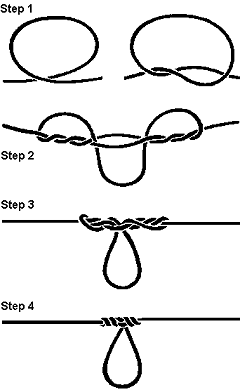
- Form a loop in the line.
- Take hold of one side of the loop, and make 6 or more turns around the line itself.
- This is the tricky part - keep open the point where the turns, or twists, are being made.
- Take hold of the other side of the loop, and pull it through the centre opening. use a finger in this loop so that it is not lost.
- Hold this loop between the teeth. Pull gently on both ends of the line, making the turns gather and pack down on either side of the loop.
- Draw up the knot by pulling the lines as tightly as possible. The turns will make the loop stand at right angles to the line.
Tucked Sheet Bend
This is a good knot to attach fly line to backing. Not very compact but a strong knot.

- Make a Blood Bight (see above) at the end of the backing line.
- Take the end of the tapered line. Pass it through the Blood Bight and make a simple Sheet Bend.
- Now pass the end of the tapered line back through the closed loop of the Sheet Bend.
- Hold both ends of the tapered line to tighten and draw into shape.
Float Stop
The float fisherman uses a running float for casting and general handiness, and stops the float from running up the line by using the Float Stop. It has the advantage that the stops moves readily over the rod guides, but grips the monofilament nylon so tightly that it will not slide over the line.
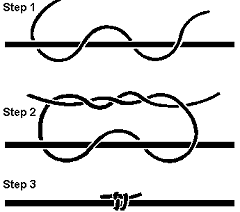 It should be made with about 12.5cm of nylon, usually the same diameter as the line itself.
It should be made with about 12.5cm of nylon, usually the same diameter as the line itself.
- Take 2 turns (3 if necessary) around the main line at the chosen point.
- Bring both ends around to form a Surgeon's Knot (see above).
- Tighten into shape bringing the coils close together.
Turle Knot
The Turle Knot is one of the easiest to tie but also is one of the weekest.
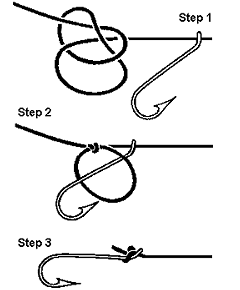 It should never be used for light lines, and there are better knots for use with heavy ones.
It should never be used for light lines, and there are better knots for use with heavy ones.
- Pass the line through the eye of the hook.
- Make a simple loop.
- Carry the end of the line on to make a Simple Overhand Knot upon the loop.
- Pass the loop over the hook.
- Draw up into shape.
Double Turle Knot
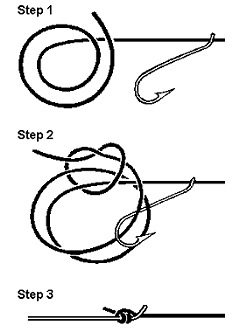 Tied in monofilament nylon, the Turle Knot may slip unless another Simple Overhand Knot is made at the end of the line where it leaves the Turle Knot.
Tied in monofilament nylon, the Turle Knot may slip unless another Simple Overhand Knot is made at the end of the line where it leaves the Turle Knot.
It is improved substantially by using the Double Turle Knot.
- Pass the line through the eye of the hook or swivel.
- Make two simple loops, and carry the line on to make a Simple Overhand Knot around both loops.
- Pass both of these loops over the hook or swivel.
- Pull on both parts of the line to draw the knot up into shape against the eye of the hook or swivel.
PITZEN-KNOT
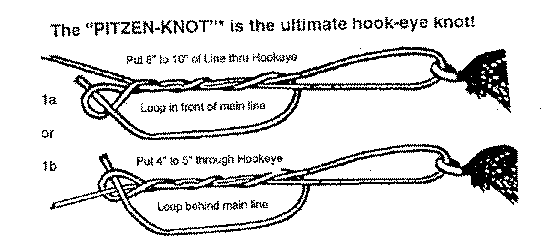
You can start with either 1a or 1b to tie this knot, which has a breaking strength close to 100% of the tippet rating.
1a -- position the fly to the right as shown!
2 -- Thread 8-10" of tippet
through the hook eye. Hold the looped tippet line and tag end with your left
thumb and finger. The tag end behind your fingers should be about 4" long. Leave
a loop as illustrated. Let the fly hang!
3 -- Make 3 twists ONLY as shown,
insert the tag end through the loop.
4 -- pull the tag end with the left hand
so the twist close up loosely toward the loop. Now pull the tippet (not the tag)
so the twists slide up toward the eye. Lubricate, and pull steadily until you
feel the knot set into place.
1b -- The main difference is that you thread only 4-5" through the hook eye, and use hackle pliers or similar to hold the fly, rather than holding it in the palm of your hand.
The Pitzen knot, invented by Edgar Pitzenbauer of Germany is easy to tie with a little practice, and results in a knot the retains 95-100% of the tippet's rated strength as opposed to 65% for a Clinch knot. The Pitzen knot is also smaller by about 40%.

Gary Fraser, Canada, ©1999-2011. All Rights Reserved.